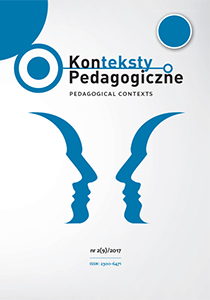Abstract
Inclusive education carries in itself a positive message of humanistic pedagogy, equal opportunities and personality selfactualization for both challenged and unchallenged learners. Yet, the implementation of its basic tenets is currently running the gauntlet of critical reevaluation in Russia’s teaching community. The study reveals controversial relationship between traditional societal values of mercy and compassion on the one hand, and the “ideals vs. reality” ambivalence on the other. The collision of humanistic values and competence resources as well as organizational issues interferes with the full acceptance of inclusive education. The research draws on questionnaire studies in Russia’s educational environment.
References
Ainscow, M. & César, M. (2006). Inclusive Education Ten Years after Salamanca: Setting the Agenda. European Journal of Psychology of Education, 21(3), 231–238.
Ainscow, M. & Miles, S. (2008). Making Education for All Inclusive: Where Next?. Prospects, 38(1), 15–34.
Avramidis, E., Bayliss, P. & Burden, R. (2002). Inclusion in Action: An inDepth Case Study of an Effective Inclusive Secondary School in the SouthWest of England. International Journal of Inclusive Education, 6(2), 143–163.
Booth, T. & Ainscow, M. (2011). Index for Inclusion: Developing Learning and Partici-pation in Schools. Bristol: CSIE.
Brandon, T. & Charlton, J. (2011). The lessons learned from developing an inclusive learning and teaching community of practice. International Journal of Inclusive Edu-cation, 15(1), 165–178.
Carroll, D. et al. (2011). School Culture for Students with Significant Support Needs: Belonging Is Not Enough. International Journal of Special Education, 26(2), 1–9.
Carter, E., Hughes, C., Gutt, C. & Copeland, S. (2005). Factors Influencing Social Interaction Among High School Students With Intellectual Disabilities and Their General Education Peers. American Journal on Mental Retardation, 110(5), 366–377.
Convention on the Rights of Persons with Disabilities and Optional Protocol. Resolution Adopted by the General Assembly, 2007. Vol. A/RES/61/1.
Ellins, J. & Porter, J. (2005). Departmental Differences in Attitudes to Special Educational Needs in the Secondary School. British Journal of Special Education, 32(4), 188–195.
Federal Law «On education in the Russian Federation», adopted 24.07.2015.
Graham, L. & Harwood, V. (2011). Developing Capabilities for Social Inclusion: Engaging Diversity through Inclusive School Communities. International Journal of Inclusive Education, 15(1), 135–152.
Hilt, L. (2015). Included as excluded and excluded as included: minority language pupils in Norwegian inclusion policy. International Journal of Inclusive Education, 19(2), 165–182.
Hotulainen, A. & Takala, M. (2014). Parents’ views on the success of integration of students with special education needs. International Journal of Inclusive Education, 18(2), 140–154.
Humphrey, N. & Symes, W. (2010). Perceptions of Social Support and Experience of Bullying among Pupils with Autistic Spectrum Disorders in Mainstream Secondary Schools. European Journal of Special Needs Education, 25(1), 77–91.
Kane, J. & Cogan, N. (2011). Towards Inclusion? Models of Behaviour Support in Secondary Schools in One Education Authority in Scotland. British Journal of Spe-cial Education, 31(2), 68–74.
Lambert, R. (2015). When I am being rushed it slows down my brain: constructing selfunderstandings as a mathematics learner. International Journal of Inclusive Edu-cation, http://dx.doi.org/10.1080/13603116.2016.1251978 [accessed: 05.12.2016].
McDougall, J. et al. (2004). High SchoolAged Youths’ Attitudes toward Their Peers with Disabilities: The Role of School and Student Interpersonal Factors. Interna-tional Journal of Disability, Development and Education, 51(3), 287–313.
Messiou, K. (2016). Research in the field of inclusive education: time for a rethink?. International Journal of Inclusive Education, http://dx.doi.org/10.1080/13603116.2016.1223184 [accessed: 09.12.2016].
Naraian, S. (2016). Inclusive education complexly defined for teacher preparation: the significance and uses of error. International Journal of Inclusive Education, http://www.tandfonline.com.scihub.io/doi/full/10.1080/13603116.2015.1134682?scroll=top&needAccess=true [accessed: 19.12.2016].
Olav, M. (2007). Diverging Paths in Upper Secondary Education: Competence Attainment among Students with Special Educational Needs. International Journal of Inclusive Education, 11(2), 215–231.
Osberg, D. & Biesta, G. (2010). The end/s of education: complexity and the conundrum of the inclusive educational curriculum. International Journal of Inclusive Education, 14(6), 593–607.
Paliokosta, P. & Blandford, S. (2010). Inclusion in School: A Policy, Ideology or Lived Experience? Similar Findings in Diverse School Cultures. Support for Learning, 25(4), 2247–2253.
Petriwskyj, A. (2010). Diversity and inclusion in the early years. International Journal of Inclusive Education, 14(2), 195–212.
Strogilos, V. (2012). The cultural understanding of inclusion and its development within a centralized system. International Journal of Inclusive Education, 16(12), 1241–1258. Vroey, A., Struyf, E. & Petry, K. (2016). Secondary school included: a literature review. International Journal of Inclusive Education, 20(2), 109–135.
Waldron, N., Cole, C. & Majd, M. (2001). The academic progress of students across in-clusive and traditional settings: A two year study Indiana inclusion study. Bloomington, IN: Indiana Institute on Disability and Community.
Whitbread, K. (2005). What Does Research Say About Inclusive Education?, http://www.wrightslaw.com/info/lre.incls.rsrch.whitbread.htm [accessed: 03.10.2016].
Wong, D. (2008). Do Contacts Make a Difference? The Effects of Mainstreaming on Student Attitudes toward People with Disabilities. Research in Developmental Dis-abilities, 29(1), 70–82.
In accordance with the recommendation of the Ministry of Science and Higher Education, which aims to counteract the practice of “ghostwriting” and “guest authorship,” all authors submitting their text for publication should attach an author’s statement which declares the contribution of each of the authors to the article. The printed and signed statement should be delivered by mail or other means to editor-in-chief Joanna Skibska or sent in the form of a scan to the following e-mail address: redakcja@kontekstypedagogczne.pl. The authors will not receive remuneration for publishing their papers. The editors reserve the right to make minor editorial changes to the articles which will not affect the substance of the article. We encourage all authors to prepare their articles in accordance with the guidelines for manuscript preparation. Download pdf file.
Authors transfer all copyrights and grant the journal the right of first publication with the work simultaneously licensed under a Creative Commons Attribution License that allows others to share the work with acknowledgement of the work's authorship and initial publication in this journal. All authors agree to the publishing of their email addresses, affiliations and short bio statements with their articles during the submission process.

